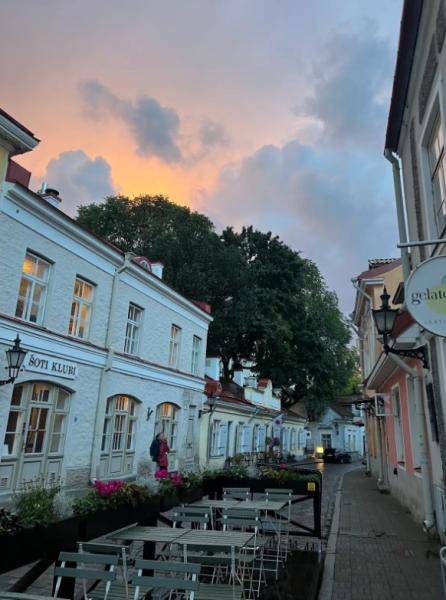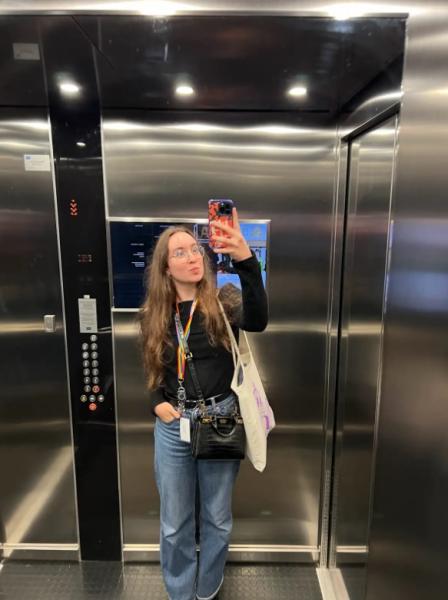This blog post was written by our student ambassador Cherep Dariia, who is a student of the International Business Administration programme at Taltech.
White nights, extended study sessions, and countless seaside sunsets
Estonia is a country full of contradictions. It has a sea, but you can’t always swim in it. In summer, there’s almost a polar day, but in winter, you’re lucky to see an hour of shining sun. It’s also comparatively small, yet it offers one of the best education systems in the world.
Studying in Tallinn: Freedom & Structure in One

Now, turning to higher education in Estonia—particularly in Tallinn, where I currently live—there are 18 universities. As a final-year business student at TalTech, I must say that the study process here is quite flexible. You have a list of compulsory subjects, but as long as you complete them successfully, you can build your program by choosing electives. This way, you regulate your workload and can even explore subjects from different fields within your faculty.
I find the study structure here quite logical. In my program, the first year was all about the basics—economics, essential marketing, and other fundamental disciplines. In the second year, we had to choose a speciality and had the option to go on an exchange. And the final year? Fully dedicated to thesis writing.
Studies here are very much focused on independent work. No one will punish you if you fail a course or push you to get good grades. Everything depends on your motivation and preparation for exams. It teaches you how to manage your time wisely. Summing up—the studies are demanding, but they also give you a lot of freedom.
Life Beyond Studies: Tallinn Through the Seasons
Student life in Tallinn doesn’t just revolve around studying. Since it’s the capital, there’s plenty to do, and the variety of activities depends a lot on the season.
Autumn is perfect for exploring Kadriorg Park, where the ground turns into a carpet of red and yellow leaves.
Winter is all about the sauna. There are several public saunas around Tallinn where you can pay for one visit, or you can book a private one to go with friends. This winter, my group of friends booked one in Iglupark, and let me tell you—it was an unforgettable experience, especially running straight into the freezing Baltic Sea in the middle of February.
Spring is when, after a long winter, students prefer to spend more time outside, enjoying the longer and warmer days. The most popular activities? Picnics! There are a lot of designated picnic spots around the city where you can bring everything you need for a proper grilling session. Also, bike rentals are super popular—Tallinn has many great seaside routes where you can cycle while enjoying the views.
Summer is, in my opinion, the best time to live in Tallinn. The city becomes fully green and even more beautiful. Since the climate here is cooler than in Central Europe, some flowers only start blooming in summer, turning the city into a fairytale. This is also festival season—there are tons of events, plus you can try different water sports or visit the Estonian Open Air Museum. And of course, there’s Jaanipäev, one of the biggest and, in my opinion, most beautiful celebrations in Estonia.

But regardless of the season, coffee is always relevant. And Tallinn is a perfect place for that. There are dozens of amazing coffee spots. Some of my favorites are Academia Kohv, Rost, La Boulangerie, and Pulla Bakery. If you’re looking for a nice brunch spot, I’d recommend Dot Cafe, Gallery Café, and many others.
How Much Does It All Cost?
So, how much do all these experiences cost for a student, and what prices should you expect when arriving in Tallinn?
First of all, it depends on your lifestyle. But some costs are more or less stable.
- A cup of coffee in the city centre or an iced matcha will cost around 4–5 euros.
- Pastries vary by place, but generally around 3 euros.
- A ticket to a public sauna is about 5–8 euros, while renting a private sauna with friends is pricier—around 110 euros for two hours.
- Monthly expenses, including dormitory rent (which ranges from 150–200 euros for a shared room), round up to about 550 euros per month.
- If you want to travel, a train ticket to Tartu (round-trip with a student discount) costs around 20 euros.In general, Tallinn offers entertainment for any budget, and let’s not forget—the sea and stunning nature are always free.
Working as a Student: Is It Possible?
The next question you might have is: can students work in Tallinn, and if so, where and how? My answer is definitely yes. Many of my friends and acquaintances work while studying.
In my opinion, it’s best to start looking for a job after your first semester—once you feel confident in your academic routine. Whether you’re allowed to work depends on your residency documents, so you’ll need to check that first. But once you’re ready, there are plenty of opportunities.
For example, at TalTech, there’s an annual internship fair where various companies come to offer internships. Many of them are for Estonian-speaking students, but there are also a lot of opportunities for international students, especially in IT.

Estonia is also known as the startup capital of Europe, and many startups are open to hiring international students. Most foreign students I know try to find work in this sector. But in general, as they say—doors open where you knock. There are plenty of opportunities here, as long as you prepare a strong CV, build your professional network, and maybe have just a little more luck than other candidates.
Student life in Tallinn goes far beyond just these four categories, but they shape most of the daily routine here. If you want to learn more about Estonia and life as a student here, stay tuned for more posts and feel free to share your thoughts on our social media!
Find out which international degree programmes are available for you in Estonia.
Read more blog posts:
